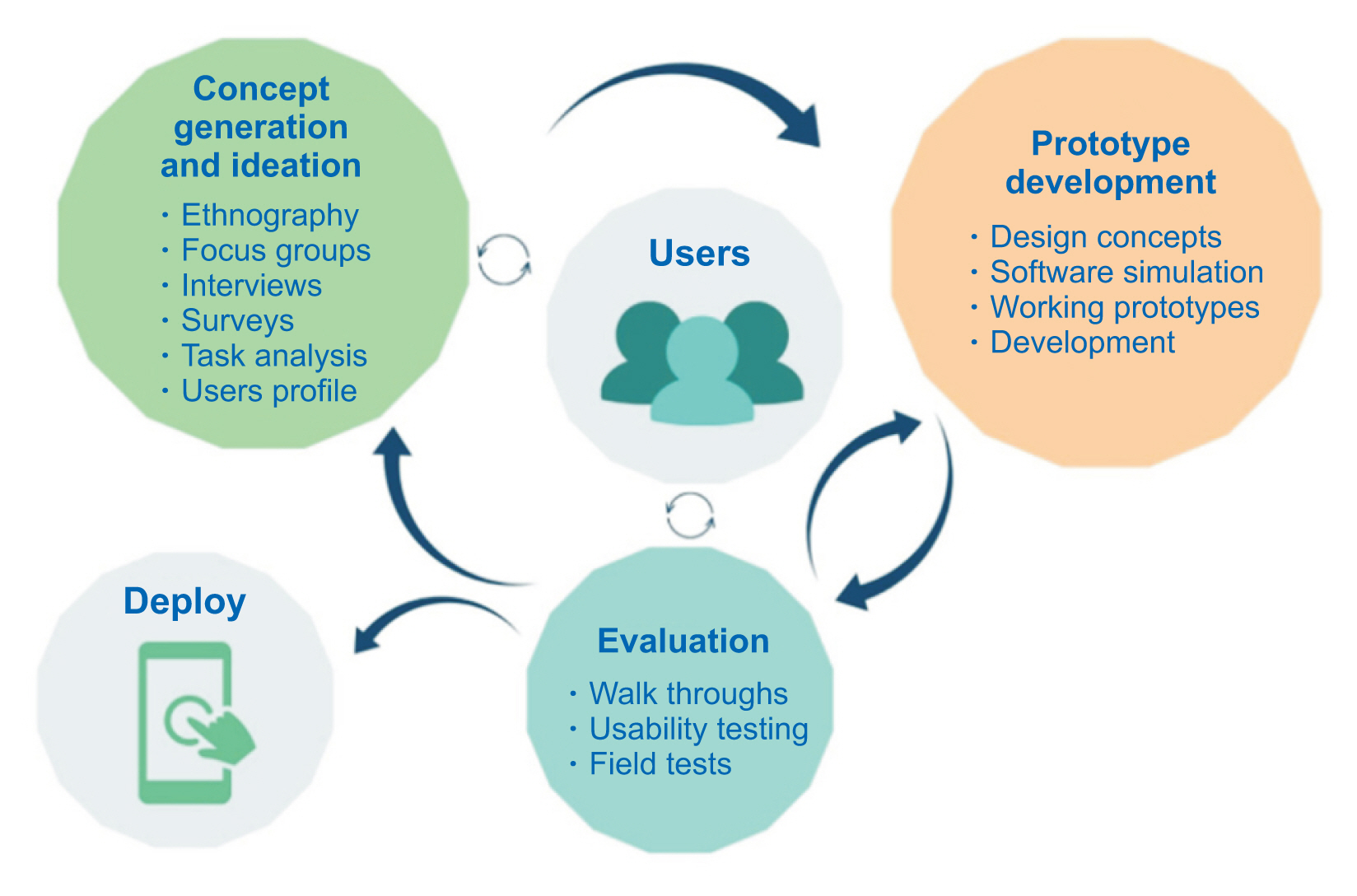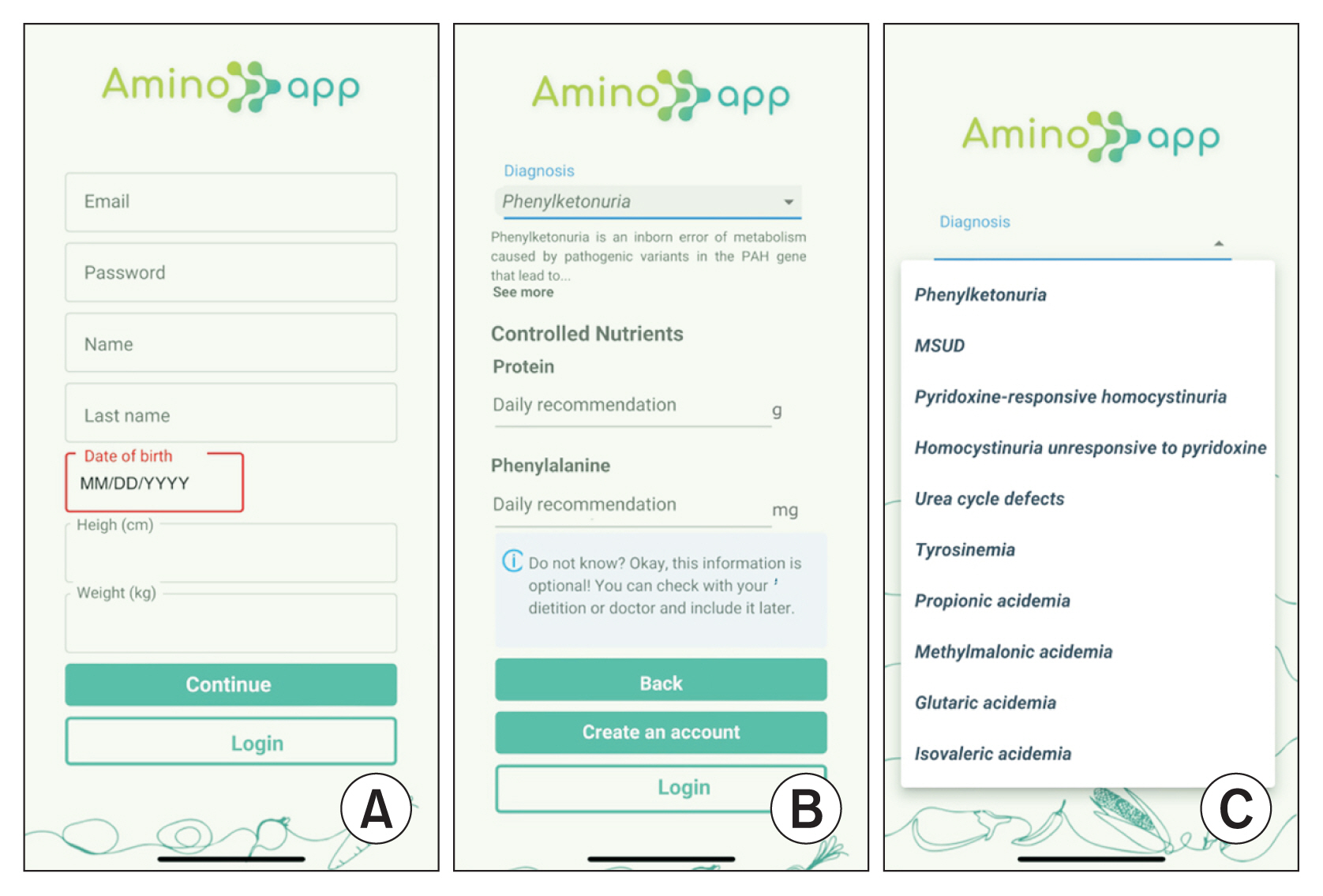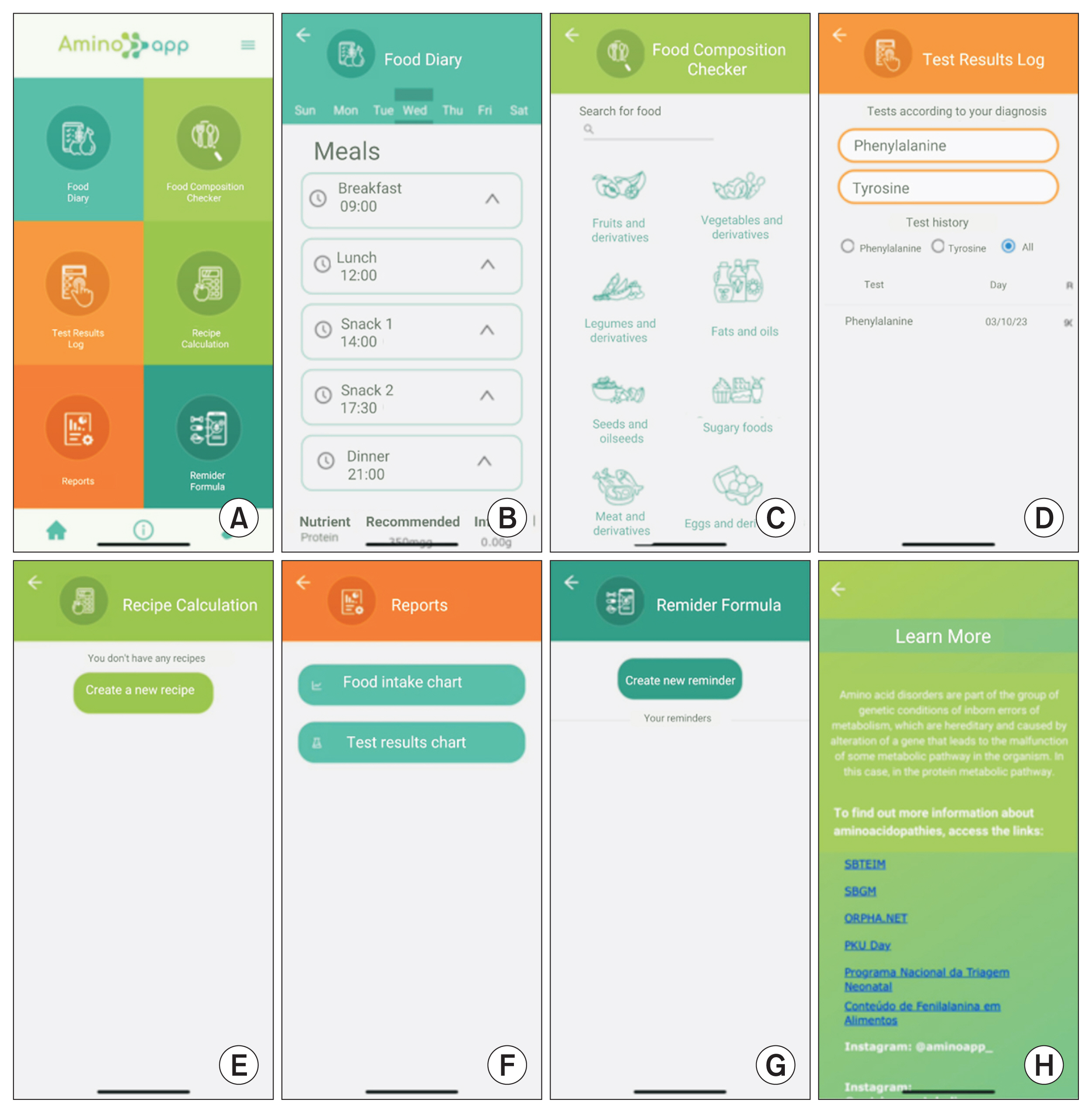Healthc Inform Res.
2024 Oct;30(4):409-415. 10.4258/hir.2024.30.4.409.
AminoApp: The First Brazilian Application for Dietary Monitoring of Inborn Errors of Metabolism in Patients on a Low-Protein Diet
- Affiliations
-
- 1Graduate Program in Medical Sciences, Federal University of Rio Grande do Sul (UFRGS), Porto Alegre, Brazil
- 2Academic in Federal University of Health Sciences of Porto Alegre (UFCSPA), Porto Alegre, Brazil
- 3Nutrition and Dietetics Service, Hospital de Clínicas de Porto Alegre, Porto Alegre, Brazil
- 4Medical Genetics Service, Hospital de Clínicas de Porto Alegre, Porto Alegre, Brazil
- 5Graduate Program in Genetics and Molecular Biology, Federal University of Rio Grande do Sul (UFRGS), Porto Alegre, Brazil
- 6Nuclimed, Clinical Research Center, Hospital de Clínicas de Porto Alegre, Porto Alegre, Brazil
- KMID: 2560543
- DOI: http://doi.org/10.4258/hir.2024.30.4.409
Abstract
Objectives
Disorders of amino acid metabolism fall under the category of inborn errors of metabolism that can be managed with a protein-restricted diet. However, adherence to such a diet often poses challenges, leading to low treatment engagement. Consequently, there is a pressing need for new resources to aid in dietary self-monitoring. The goal is to develop and implement “AminoApp,” an application tailored for dietary self-monitoring in patients with inborn errors of metabolism who are on a low-protein diet.
Methods
The design and development of the application adhered to the user-centered design method. This approach emphasizes active participation and collaboration between users and designers/researchers throughout all stages of product development, including requirement gathering, prototype development, and evaluation. Usability was evaluated using the System Usability Scale, which has been validated in Portuguese.
Results
The application’s features include a food diary, a food consultation area, exam records, a recipe calculator, and reports on diet composition and metabolic control. The usability test included four patients on a low-protein diet, three caregivers, and three healthcare professionals. The average usability score was 84.9, with averages of 77.5 for patients, 85.8 for caregivers, and 91.6 for professionals, indicating that the application is user-friendly.
Conclusions
AminoApp is the first application developed in Brazil designed to assist in managing inborn errors of metabolism that require a protein-restricted diet. It was found to be easy to use, and the initial results are promising. Further research is necessary to evaluate the impact of the application on metabolic control and treatment adherence.
Figure
Reference
-
References
1. Saudubray JM, van den Berghe G, Walter JH. Inborn metabolic diseases: diagnosis and Treatment. 5th ed. Heidelberg, Germany: Springer;2012. https://doi.org/10.1007/978-3-642-15720-2.
Article2. Ferreira CR, Rahman S, Keller M, Zschocke J; ICIMD Advisory Group. An international classification of inherited metabolic disorders (ICIMD). J Inherit Metab Dis. 2021; 44(1):164–77. https://doi.org/10.1002/jimd.12348.
Article3. Agana M, Frueh J, Kamboj M, Patel DR, Kanungo S. Common metabolic disorder (inborn errors of metabolism) concerns in primary care practice. Ann Transl Med. 2018; 6(24):469. https://doi.org/10.21037/atm.2018.12.34.
Article4. MaCdonald A, van Rijn M, Feillet F, Lund AM, Bernstein L, Bosch AM, et al. Adherence issues in inherited metabolic disorders treated by low natural protein diets. Ann Nutr Metab. 2012; 61(4):289–95. https://doi.org/10.1159/000342256.
Article5. Teruya KI, Remor E, Schwartz IV. Factors that increase risk for poor adherence to phenylketonuria treatment in Brazilian patients. Am J Med Genet A. 2021; 185(7):1991–2002. https://doi.org/10.1002/ajmg.a.62195.
Article6. Vieira TA, Nalin T, Krug BC, Bittar CM, Netto CB, Schwartz IVD. Adherence to treatment of phenylketon-uria: a study in southern Brazilian patients. J Inborn Errors Metab Screen. 2015; 3:2326409815579861. https://doi.org/10.1177/2326409815579861.
Article7. Perez-Jover V, Sala-Gonzalez M, Guilabert M, Mira JJ. Mobile apps for increasing treatment adherence: systematic review. J Med Internet Res. 2019; 21(6):e12505. DOI: 10.2196/12505.
Article8. Barra DC, Paim SM, dal Sasso GT, Colla GW. Methods for developing mobile apps in health: an integrative review of the literature. Texto & Contexto-Enfermagem. 2017; 26(4):1–12. https://doi.org/10.1590/0104-07072017002260017.
Article9. McCurdie T, Taneva S, Casselman M, Yeung M, Mc-Daniel C, Ho W, et al. mHealth consumer apps: the case for user-centered design. Biomed Instrum Technol. 2012. Suppl. 49–56. https://doi.org/10.2345/0899-8205-46.s2.49.
Article10. Jordan PW, Thomas B, McClelland IL, Weerdmeester B. Usability evaluation in industry. Boca Raton (FL): CRC Press;1996.11. Tenorio JM, Cohrs FM, Sdepanian VL, Pisa IT, Marin HD. Desenvolvimento e Avaliacao de um Protocolo Eletronico para Atendimento e Monitoramento do Paciente com Doenca Celiaca. Rev Informatica Teorica e Apl. 2011; 17(2):210–20. https://doi.org/10.22456/2175-2745.12119.
Article12. Sauro J. 5 Ways to interpret a SUS score [Internet]. Denver (CO): MeasuringU;2018. [cited at 2024 Jul 16]. Available from: https://measuringu.com/interpret-sus-score/.13. Nielsen J. Estimating the number of subjects needed for a thinking aloud test. Int J Hum Comput Stud. 1994; 41(3):385–97. https://doi.org/10.1006/ijhc.1994.1065.
Article14. Brazilian food composition table (TBCA) [Internet]. Sao Paulo, Brazil: Universidade de Sao Paulo, Food Research Center;2023. [cited at 2024 Jul 16]. Available from: https://www.tbca.net.br/.15. United States Department of Agriculture. FoodData Central search results [Internet]. Washington (DC): United States Department of Agriculture;2018. [cited at 2024 Jul 16]. Available from: https://fdc.nal.usda.gov/fdc-app.html#/.16. Agencia Nacional de Vigilância Sanitaria (ANVISA). Phenylalanine content in foods [Internet]. Sao Paulo, Brazil: ANVISA;c2023. [cited at 2024 Jul 16]. Available from: https://app.powerbi.com/view?r=eyJrIjoiODNl-ZDRiZWUtOTM3Ni00ZTBmLTgxYWUtNWUzM2ZkNTk5NTUyIiwidCI6ImI2N2FmMjNmLWMzZjMtNGQzNS04MGM3LWI3MDg1ZjVlZGQ4MSJ9.17. Ho G, Ueda K, Houben RF, Joa J, Giezen A, Cheng B, et al. Metabolic diet app suite for inborn errors of amino acid metabolism. Mol Genet Metab. 2016; 117(3):322–7. https://doi.org/10.1016/j.ymgme.2015.12.007.
Article18. Evans S, Ashmore C, Daly A, Dhadwar P, Syed A, Lecocq O, et al. Efficacy of a new low-protein multimedia diet app for PKU. Nutrients. 2022; 14(11):2182. https://doi.org/10.3390/nu14112182.
Article19. Lim JY, Ali NM, Rajikan R, Amit N, Hamid HA, Leong HY, et al. Need analysis of a dietary application among caregivers of patients with disorders of amino acid metabolism (AAMDs): a mixed-method approach. Int J Med Inform. 2023; 177:105120. https://doi.org/10.1016/j.ijmedinf.2023.105120.
Article20. Cazzorla C, Bensi G, Biasucci G, Leuzzi V, Manti F, Musumeci A, et al. Living with phenylketonuria in adulthood: the PKU attitude study. Mol Genet Metab Rep. 2018; 16:39–45. https://doi.org/10.1016/j.ymgmr.2018.06.007.
Article
- Full Text Links
- Actions
-
Cited
- CITED
-
- Close
- Share
- Similar articles
-
- Seventeen Years Experience on Inborn Errors of Metabolism A Study for Future Development of Inborn Errors of Metabolism in Korea
- Neonatal Screening for Inborn Errors of Metabolism
- Types of Special Infant Formulas Marketed in Korea and Their Indications
- Renal Manifestations of Inborn Errors of Metabolism
- Renal replacement therapy in neonates with an inborn error of metabolism




